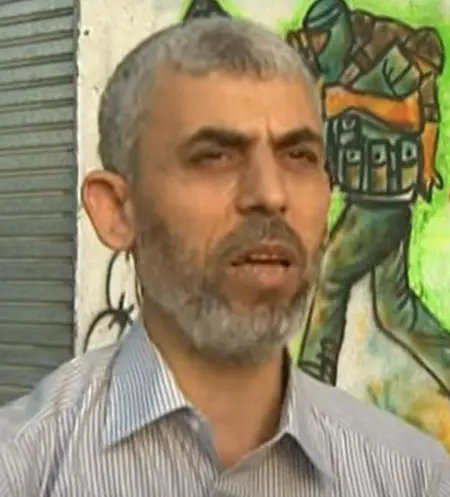Yahya Sinwar
(1962 - )

Yahya Ibrahim Hassan Sinwar was born in 1962 in a refugee camp in Khan Yunis and attended the Khan Yunis Secondary School for Boys. After high school, he attended the Islamic University of Gaza, graduating with a bachelor’s degree in Arabic studies.
While attending university in 1982, Sinwar was arrested for the first time. In prison, he became friendly with Palestinian activists and decided to dedicate himself to the Palestinian cause.
In 1985, Sinwar founded Hamas’s security branch, whose job included punishing “morality” offenders and killing Palestinians suspected of collaborating with Israel. His enthusiasm for executing collaborators led Israeli interrogators to refer to him as the “the Butcher from Khan Younis.”
 |
In 1988, Sinwar was arrested again and sentenced to four life terms in an Israeli prison for attempted murder and causing grievous bodily harm through sabotage. During his confinement, Sinwar’s life was saved when he had brain surgery, reportedly to remove a tumor.
Sinwar was released in 2011, one of a total of 1,000 Palestinian prisoners exchanged for a single Israeli soldier, Gilad Shalit, who was captured in 2006 and held hostage in Gaza for five years by Hamas. Sinwar was the most senior prisoner released. He said he devoted his time in jail to studying his enemy.
Sinwar is believed to be responsible for the detention, torture, and killing of a Hamas commander, Mahmoud Ishtiwi, who was initially held for embezzlement in 2015. Later, after he was murdered, Ishtiwi was accused of committing “moral crimes” – amid suspicions of gay sex — that Mr. Sinwar feared could lead to extortion and compromise Hamas.
Al Resalah, a Hamas-affiliated newspaper in Gaza, credited Sinwar with coordinating the communications between the group’s senior commanders, who were hiding from the Israelis during confrontations with the Israeli army and the Qassam Brigades.
In February 2017, Sinwar was secretly elected the leader of Hamas, replacing Ismail Haniyeh. In March, he established a Hamas-controlled administrative committee for the Gaza Strip, which meant that he opposed any power-sharing with the Palestinian Authority.
On May 16, 2018, Sinwar told Al Jazeera that Hamas would pursue peaceful, popular resistance
but rejected the terms of the international community for being recognized as a representative of the Palestinians. Israel was unconvinced by his statement since he did not repudiate the Hamas Covenant calling for the killing of Jews and the destruction of Israel.
According to Israeli sources, Sinwar is a “bitter enemy” of the Egyptians and supports working with Islamic State affiliates fighting the Egyptian Army in the Sinai Desert. He also established a close relationship with Iran, which began to provide significant funding, arms, and training to Hamas.
In March 2021, Sinwar was elected to a second four-year term as the head of the organization’s Gaza political bureau in an election held in secret. He is the highest-ranking Hamas official in Gaza and the Strip’s de facto ruler. He is the second most powerful member of Hamas after Ismail Haniyeh.
Sinwar was believed to be the mastermind behind the October 7, 2023, infiltration of Israel and the massacre of soldiers and civilians that provoked Israel to declare war on Hamas.
Sources: Dov Lieber, “We Saved Hamas Leader’s Life, Says Israel Ex-Prison Chief, Dismissing Strike Complaints,” Times of Israel, (May 11, 2017).
Isabel Kershner, “Hamas Appoints Hard-Line Militant as Gaza Leader,” New York Times, (February 13, 2017).
“Yahya Sinwar,” Wikipedia.
Aaron Boxerman, “Sinwar wins 2nd term as Hamas Gaza chief after tense election standoff,” Times of Israel, (March 10, 2021).
Photos: Top: Screengrab Freed senior Hamas leader vows to fight on,
Al Jazeera English, (October 29, 2011).
Right - بلال الدويك, CC BY-SA 3.0 via Wikimedia Commons.


